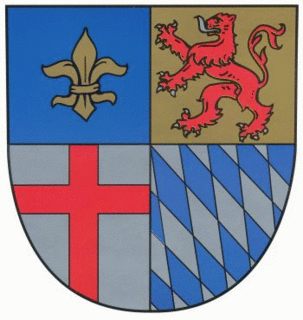External links
- Official website

Coordinates: 50°33′58″N7°16′52″E / 50.566°N 7.281°E
| This Neuwied district location article is a stub. You can help Wikipedia by expanding it. |
Linz am Rhein is a Verbandsgemeinde ("collective municipality") in the district of Neuwied, in Rhineland-Palatinate, Germany. The seat of the eponymously named Verbandsgemeinde is in the town of Linz am Rhein.
The VerbandsgemeindeLinz am Rhein consists of the following Ortsgemeinden ("local municipalities"):
Coordinates: 50°33′58″N7°16′52″E / 50.566°N 7.281°E
| This Neuwied district location article is a stub. You can help Wikipedia by expanding it. |

Linz am Rhein is a municipality in the district of Neuwied, in Rhineland-Palatinate, Germany. It is situated on the right bank of the river Rhine near Remagen, approx. 25 km southeast of Bonn and has about 6,000 inhabitants. It is the sister city of Marietta, Georgia in the United States, Linz in Austria and Pornic in France.

Waldalgesheim is an Ortsgemeinde – a municipality belonging to a Verbandsgemeinde, a kind of collective municipality – in the Mainz-Bingen district in Rhineland-Palatinate, Germany. It is best known as the site of the Iron Age Waldalgesheim chariot burial.
Sankt Goar-Oberwesel is a Verbandsgemeinde in the Rhein-Hunsrück district, in Rhineland-Palatinate, Germany. It is situated on the left bank of the Rhine, approx. 30 km southeast of Koblenz. Its seat is in Oberwesel.

Loreley is a Verbandsgemeinde in the Rhein-Lahn-Kreis, in Rhineland-Palatinate, Germany. It was historically part of the Duchy of Nassau, a sovereign state until 1866, and is currently located in the Nassau Nature Park. It is situated on the right bank of the Rhine, adjacent to the Nassau district and approx. 25 km southeast of Koblenz. Its seat is in Sankt Goarshausen. It was named after the Loreley Rock. On 1 July 2012, it merged with the former Verbandsgemeinde Braubach. Initially, the new Verbandsgemeinde was named "Braubach-Loreley", but it was renamed "Loreley" on 1 December 2012.

Vettelschoß is a municipality in the district of Neuwied in Rhineland-Palatinate, Germany. It includes the localities of Kalenborn, Kau, Oberwillscheid, and Willscheid, and forms part of the Verbandsgemeinde of Linz am Rhein.
Heidesheim am Rhein is a former Verbandsgemeinde in the district Mainz-Bingen in Rhineland-Palatinate, Germany. The seat of the Verbandsgemeinde was in Heidesheim am Rhein. In 2010 a reform of the communal structure was requested by the Rhineland-Palatinate government. As a result of this on 1 July 2019 Wackernheim and Heidesheim were incorporated into the city of Ingelheim.
Mendig is a Verbandsgemeinde in the district Mayen-Koblenz, in Rhineland-Palatinate, Germany. The seat of the municipality is in Mendig.
Rhens is a former Verbandsgemeinde in the district Mayen-Koblenz, in Rhineland-Palatinate, Germany. The seat of the municipality was in Rhens. On 1 July 2014 it merged into the new Verbandsgemeinde Rhein-Mosel.
Emmelshausen is a Verbandsgemeinde in the Rhein-Hunsrück district, in Rhineland-Palatinate, Germany. Its seat is in Emmelshausen.
Kastellaun is a Verbandsgemeinde in the Rhein-Hunsrück district, in Rhineland-Palatinate, Germany. Its seat is in Kastellaun. On 1 July 2014 it was expanded with 3 municipalities from the former Verbandsgemeinde Treis-Karden.
Rheinböllen is a Verbandsgemeinde in the Rhein-Hunsrück district, in Rhineland-Palatinate, Germany. Its seat is in Rheinböllen. The current mayor is Arno Imig (CDU).
Bad Ems is a former Verbandsgemeinde in the Rhein-Lahn-Kreis, in Rhineland-Palatinate, Germany. In January 2019 it was merged into the new Verbandsgemeinde Bad Ems-Nassau. Its seat was in Bad Ems.
Diez is a Verbandsgemeinde in the Rhein-Lahn-Kreis, in Rhineland-Palatinate, Germany. Its seat is in Diez.
Katzenelnbogen is a former Verbandsgemeinde in the Rhein-Lahn-Kreis, in Rhineland-Palatinate, Germany. Its seat was in Katzenelnbogen. On 1 July 2019, it was merged into the new Verbandsgemeinde Aar-Einrich.
Nassau is a former Verbandsgemeinde in the Rhein-Lahn-Kreis, in Rhineland-Palatinate, Germany. In January 2019 it was merged into the new Verbandsgemeinde Bad Ems-Nassau. Its seat was in Nassau.
Nastätten is a Verbandsgemeinde in the Rhein-Lahn-Kreis, in Rhineland-Palatinate, Germany. Its seat is in Nastätten.
Rhein-Mosel is a Verbandsgemeinde in the district Mayen-Koblenz, in Rhineland-Palatinate, Germany. It is situated along the lower course of the river Moselle, south-west of Koblenz. The seat of the municipality is in Kobern-Gondorf. It was formed on 1 July 2014 by the merger of the former Verbandsgemeinden Untermosel and Rhens.

The Rhine-Westerwald Nature Park is a nature park in Germany that covers an area of around 470 km² to the east of the River Rhine and in the north of the state of Rhineland-Palatinate between Neuwied and Unkel. It extends from the Rhine over its eastern bank terraces up to the first hill ridge of the Lower Westerwald. The Rhine-Westerwald Nature Park is over 50 years old, making it the oldest one in Germany. It was founded in 1962 and celebrated its 50th anniversary in 2012. Its legal owner is the society of Naturpark Rhein-Westerwald.
Bad Ems-Nassau is a Verbandsgemeinde in the Rhein-Lahn-Kreis, in Rhineland-Palatinate, Germany. The seat of the Verbandsgemeinde is in Bad Ems. It was formed on 1 January 2019 by the merger of the former Verbandsgemeinden Bad Ems and Nassau.
The Castle of Linz is a castle in Linz am Rhein, Germany, built between 1364 and 1368 by Heinrich von Virneburg, who was the archbishop of Cologne at the time. The main function of the castle was to collect river tolls. During the Neuss War in 1475, the castle was besieged and badly damaged. The castle lost its importance when the town of Linz am Rhein was sold to Prussia in 1820. In 1942–1945, during the Second World War, the castle was used as a prison. The structure today is now privately owned and used as a public venue.